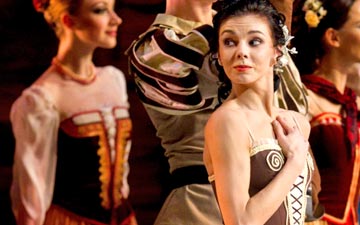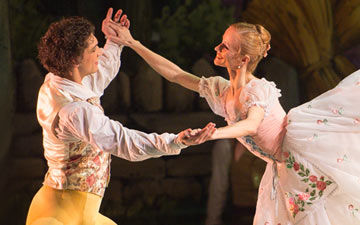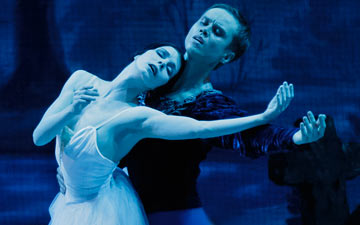
© The Mikhailovsky Theatre. (Click image for larger version)
Mikhailovsky Ballet
Giselle
London, Coliseum
26 March 2013
www.mikhailovsky.ru
What a thrilling experience to see a truly airborne Giselle! Natalia Osipova transmutes her buoyancy as a peasant girl in Act I into unearthly flight in Act II. She’s tireless, impelled by a supernatural force until she fades away in a spine-tingling ending, a spirit no longer. Osipova’s Giselle has given every last atom of herself to Albrecht and to us, her witnesses.
The Mikhailovsky’s 2007 production is by Nikita Dolgushin (a renowned Albrecht), who died last year. With Osipova and Ivan Vasiliev in the leading roles, the ballet seems split between two conventions. The corps are well-drilled and old-fashioned: as villagers in Act I, their every gesture is stylised, their reactions identical. When a hunting horn sounds, each peasant girl simultaneously raises a hand to her ear; when Giselle breaks down at the start of her mad scene, everyone turns their backs in unison. Yet Osipova and Vasiliev inhabit their characters with vivid realism, responding to each other and everyone on stage in Act I as naturally as possible.
The autumnal set for the first act has a picturesque castle on the backdrop and a substantial rustic dwelling for Giselle and her mother. It might even be a hostelry, since mother (Anna Novosyolova) appears a significant figure in the grape harvest celebrations. Once the ducal hunting party has dispersed after their refreshment, mother presides over the village festivities. The ‘Peasant pas de deux’ couple, for example, address their gestures to her, seated downstage right, as do their fellow entertainers. Giselle performs her party-piece solo before her mother’s eyes, for the benefit of Albrecht rather than for aristocratic Bathilde. Yet Mother had earlier discouraged Giselle from dancing; meanwhile nobody is available to look after the noble visitors inside the cottage.
Bathilde (Olga Semyonova) is a fantastical figure, kittted out in a huge hat and a red velvet costume covered in gold braid. Osipova’s Giselle is entranced by the gold embroidery, even holding Bathilde’s train as she steps into the cottage. Her every reaction is convincing. This Giselle really does have a heart problem, which she tries to hide from Albrecht. Instead of happily joining in as the villagers wheel in a circle, she fakes her place at the end of the line, fooling him into thinking she has quickly recovered from her breathlessness. She’s going to die from a broken heart, a chill creeping through her veins, not from a self-inflicted stab with Albrecht’s sword.
Osipova’s very first step after her entrance in Act I, a bouncy ballonné, has such extraordinary lift-off that it foretells her elevation as a weightless Wili. Instantly, you know you’ll be watching an exceptional performance. She and Vasiliev are so well matched that they bound together in Act I with the exhilaration of youngsters in love. His Albrecht is genuinely devastated when his deception is exposed; her mad scene, ferocious in its intensity, almost tips him over the edge. In Act II, he is torn between the weight of his guilt and the spell that compels him to keep dancing.

© The Mikhailovsky Theatre. (Click image for larger version)
Because Vasiliev is the same height as Osipova, he becomes almost invisible in the Act II lifts. She floats above him, the long skirts of her Romantic tutu hiding much of his body. Dancing on her own, she seems suspended as she flies across the stage. Never has the series of soubresauts, feet tucked up beneath her, looked more persuasive; rather than skimming the stage in the speedy sequence of entrechats and relevés sautés, she appears pulled upwards, in defiance of gravity. Her initial action, after being summoned by the Queen of the Wilis, is to whirl as if electrified into a demonic afterlife. She’s more terrifying than Ekaterina Borchenko’s Myrthe, who labours in comparison.
When Osipova joins Vasiliev for the legato pas de deux, she extends her leg so slowly in the first arabesque penchée that you believe with him he must be dreaming. She hovers over him in mourning, her eerie vitality dimmed until her Wili nature takes over; she has to call on the strength of her human love for Albrecht to dance for him instead of avenging herself at Myrthe’s command. Vasiliev understands that the ballet is about Giselle, not Albrecht: his frantic leaps are not intended to draw attention to his virtuoso skill but to suffer until she saves him.
As dawn colours the backdrop, Osipova’s Giselle is sapped of supernatural energy. She wilts, vanishing into the gloaming instead of her grave. No longer doomed to be a spirit, she won’t be joining the ghostly sisterhood again. She leaves Albrecht a broken man, her audience stunned into silence even after the curtain descends.
Mikhail Mekler’s lighting for Act II creates a miraculously insubstantial other world (apart from some oddly mobile scenery on the first night). The Wili horde is silent, dutiful. After seeing off Hilarion (Vladimir Tsal) to a watery grave, they serve as a discreet frame for the drama between Giselle and Albrecht, neat but not implacable. Borchenko’s Myrthe is underwhelming, incapable of ruling the action. Tsal’s resentful Hilarion bridges the production’s two conventions: his mime is melodramatic but his presence is plausible. When Osipova’s Giselle tells him she’s not in love with him, you feel for him – and for her. For all her power as a dancer, Osipova endows Giselle with a tragic poignancy that illuminates both acts of the ballet, keeping it entrancingly alive for modern generations.

















You must be logged in to post a comment.